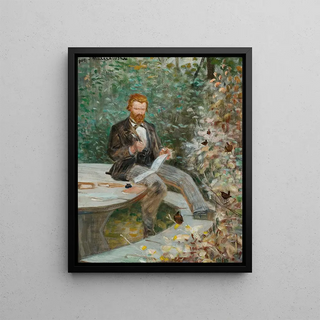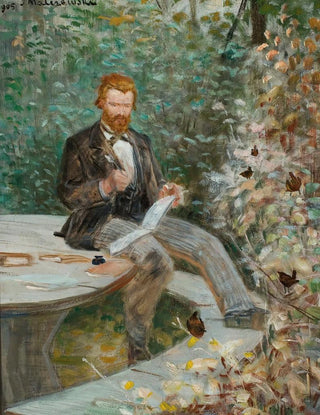Art print | Portrait of Adolf Dygasiński - Jacek Malczewski


View from behind

Frame (optional)
Portrait of Adolf Dygasiński - Jacek Malczewski – Captivating Introduction
In the rich and complex universe of Polish art, the "Portrait of Adolf Dygasiński" by Jacek Malczewski stands out for its emotional intensity and psychological depth. This artwork, revealing an era where art intertwines with social and political concerns, invites the viewer to delve into the intimacy of its subject. Dygasiński, an influential writer and intellectual, is captured in a moment of reflection, his penetrating gaze seemingly addressing the world around him. The art print of this portrait, imbued with Malczewski's sensitivity, is much more than a simple image; it is a dialogue between the artist and his model, a meeting between the past and the present.
Style and uniqueness of the work
Jacek Malczewski's style is characterized by a harmonious blend of realism and symbolism, an approach that gives his works a narrative and poetic dimension. In the "Portrait of Adolf Dygasiński," the artist employs a palette of rich colors and delicate textures to create an atmosphere that is both intimate and vibrant. Dygasiński's face, delicately modeled, emerges from a nuanced background that emphasizes the depth of his expression. The meticulous details, such as the play of light on his face and the shadows surrounding him, demonstrate Malczewski's technical mastery and his attention to the psychology of his subjects. This work stands out not only for its aesthetic but also for its ability to evoke deep emotions, making each gaze a journey into the soul of the model.
The artist and his influence
Jacek Malczewski, an emblematic figure of Polish art at the end of the 19th and beginning of the 20th century, is often regarded as the father of Polish symbolism. His work draws influence from Impressionism and Post-Impressionism, while incorporating elements of Polish folklore and mythology. Malczewski was able to translate the concerns of his time through a unique aesthetic, blending reality with spirituality. His commitment to social and political themes, as well as his exploration

Matte finish

View from behind

Frame (optional)
Portrait of Adolf Dygasiński - Jacek Malczewski – Captivating Introduction
In the rich and complex universe of Polish art, the "Portrait of Adolf Dygasiński" by Jacek Malczewski stands out for its emotional intensity and psychological depth. This artwork, revealing an era where art intertwines with social and political concerns, invites the viewer to delve into the intimacy of its subject. Dygasiński, an influential writer and intellectual, is captured in a moment of reflection, his penetrating gaze seemingly addressing the world around him. The art print of this portrait, imbued with Malczewski's sensitivity, is much more than a simple image; it is a dialogue between the artist and his model, a meeting between the past and the present.
Style and uniqueness of the work
Jacek Malczewski's style is characterized by a harmonious blend of realism and symbolism, an approach that gives his works a narrative and poetic dimension. In the "Portrait of Adolf Dygasiński," the artist employs a palette of rich colors and delicate textures to create an atmosphere that is both intimate and vibrant. Dygasiński's face, delicately modeled, emerges from a nuanced background that emphasizes the depth of his expression. The meticulous details, such as the play of light on his face and the shadows surrounding him, demonstrate Malczewski's technical mastery and his attention to the psychology of his subjects. This work stands out not only for its aesthetic but also for its ability to evoke deep emotions, making each gaze a journey into the soul of the model.
The artist and his influence
Jacek Malczewski, an emblematic figure of Polish art at the end of the 19th and beginning of the 20th century, is often regarded as the father of Polish symbolism. His work draws influence from Impressionism and Post-Impressionism, while incorporating elements of Polish folklore and mythology. Malczewski was able to translate the concerns of his time through a unique aesthetic, blending reality with spirituality. His commitment to social and political themes, as well as his exploration






